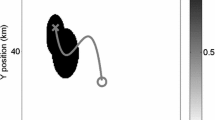Abstract
A three-dimensional integrated model is developed for simulating transport and final fate of oil spills in seas. The model contains two main modules, flow and transport-fate modules. The flow module uses an unstructured finite-volume wave-ocean coupling model. Using unstructured meshes provides great flexibility for modeling the flow in complex geometries of tidal creeks, barriers and islands. In the transport-fate module the oil dispersion is solved using a particle-tracking method. Horizontal diffusion is simulated using random walk techniques in a Monte Carlo framework, whereas the vertical diffusion process is solved on the basis of the Langeven equation. The model simulates the most significant processes that affect the motion of oil particles, such as advection, surface spreading, evaporation, dissolution, emulsification and turbulent diffusion as well as the interaction of the oil particles with the shoreline, sedimentation and the temporal variations of oil viscosity, density and surface tension. The model simulates either continuous or instantaneous oil spills, and also other toxic matter. This model has been applied to simulate the oil spill accident in the Bohai Sea. In comparison with the observations, the numerical results indicate that the model is reasonably accurate.
Similar content being viewed by others
References
Elliott A J. Shear diffusion and the spread of oil in the surface layers of the North Sea. Ocean Dynam, 1986, 39(3): 113–137
Periáñez R, Pascual-Granged A. Modelling surface radioactive, chemical and oil spills in the Strait of Gibraltar. Comput Geoscien, 2008, 34(2): 163–180
Wang S D, Shen Y M, Guo Y K, et al. Three-dimensional numerical simulation for transport of oil spills in seas. Ocean Eng, 2008, 35(5–6): 503–510
Chao X B, Shankar N J, Cheong H F. Two- and three-dimensional oil spill model for coastal waters. Ocean Eng, 2001, 28(12): 1557–1573
Chao X B, Shankar N J, Wang S. Development and application of oil spill model for Singapore coastal waters. J Hydraul Eng-ASCE, 2003, 129(7): 495–503
Lonin S A. Lagrangian model for oil spill diffusion at sea. Spill Sci T, 1999, 5(5): 331–336
Shen H T, Yapa P D. Oil slick transport in rivers. J Hydraul Eng-ASCE, 1988, 114(5): 529–543
Shen H T, Yapa P D, Petroski M E. Simulation of Oil Slick Transport in Great Lakes Connecting Channels. Technical Report, Department of Civil and Environmental Engineering, Clarkson University. 1986
Yapa P D, Shen H T, Angammana K S. Modeling oil-spills in a river lake system. J Marine Syst, 1994, 4(6): 453–471
Wang S D, Shen Y M, Zheng Y H. Two-dimensional numerical simulation for transport and fate of oil spills in seas. Ocean Eng, 2005, 32(13): 1556–1571
Periáñez R. Chemical and oil spill rapid response modelling in the Strait of Gibraltar-Alborán Sea. Ecol Model, 2007, 207(2–4): 210–222
Chen C S, Huang H S, Beardsley R C, et al. A finite volume numerical approach for coastal ocean circulation studies: Comparisons with finite difference models. J Geophys Res, 2007, 112: C3018, doi: 10.1029/2006JC003485
Mellor G L, Donelan M A, Oey L Y. A surface wave model for coupling with numerical ocean circulation models. J Atmos Ocean Tech, 2008, 25(10): 1785–1807
Mellor G L. Some consequences of the three-dimensional current and surface wave equations. J Phys Oceanogr, 2005, 35(11): 2291–2298
Blumberg A F, Mellor G L. A description of a three-dimensional coastal ocean circulation model. In: Heaps N, ed. Three-Dimensional Coastal Ocean Models. Washington: American Geophysics Union, 1987. 1–16
Mellor G L. The three-dimensional current and surface wave equations. J Phys Oceanogr, 2003, 33(9): 1978–1989
Karypis G, Kumar V. Metis: A Software Package for Partitioning Unstructured Graphs, Partitioning Meshes, and Computing Fill-Reducing Orderings of Sparse Matrices. Technical Report, Department of Computer Science, University of Minnesota. 1998
Chen C S, Liu H D, Beardsley R C. An unstructured grid, finite-volume, three-dimensional, primitive equations ocean model: Application to coastal ocean and estuaries. J Atmos Ocean Tech, 2003, 20(1): 159–186
Zhang B, Zhang C Z, Ozer J. Surf-a simulation model for the behavior of oil slicks at sea. In: Ozer J, ed. Oil Pollution: Environmental Risk Assessment (OPERA). Belgium: Caligrafic Dewarichet, 1991. 61–85
Fischer H B, List E J, Koh R, et al. Mixing in Inland and Coastal Waters. New York: Academic Press, 1979
Tkalich P, Chan E S. Vertical mixing of oil droplets by breaking waves. Mar Pollut Bull, 2002, 44(11): 1219–1229
Delvigne G, Sweeney C E. Natural dispersion of oil. Oil Chem Pollut, 1988, 4(4): 281–310
Proctor R, Flather R A, Elliott A J. Modelling tides and surface drift in the Arabian Gulf: Application to the gulf oil spill. Cont Shelf Res, 1994, 14(5): 531–545
Editorial Board for Marine Atlas. Marine Atlas of the Bohai Sea, Yellow Sea and East China Sea: Hydrology (in Chinese). Beijing: China Ocean Press, 1992
Qiao L L, Bao X W, Wu D X. The observed currents in summer in the Bohai Sea. Chin J Limnol Oceanogr, 2008, 26(2): 130–136
Thorpe S A. On the clouds of bubbles formed by breaking windwaves in deep water, and their role in air-sea gas transfer. Philos Trans R Soc London (A), 1982, 304(1483): 155–210
Shen Y M, Li Y C, Chwang A T. Quasi-three-dimensional refined modelling of turbulent flow and water quality in coastal waters. Sci China Ser E-Tech Sci, 1996, 39(4): 342–353
Author information
Authors and Affiliations
Corresponding author
Rights and permissions
About this article
Cite this article
Wang, J., Shen, Y. Development of an integrated model system to simulate transport and fate of oil spills in seas. Sci. China Technol. Sci. 53, 2423–2434 (2010). https://doi.org/10.1007/s11431-010-4059-4
Received:
Accepted:
Published:
Issue Date:
DOI: https://doi.org/10.1007/s11431-010-4059-4




